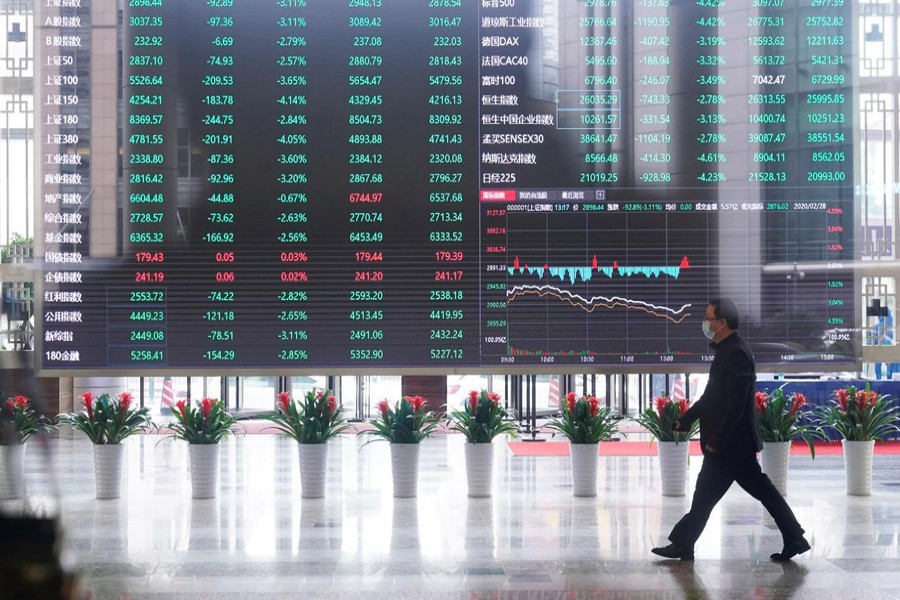Asian shares bounced and bond yields rose from historic lows on Tuesday as speculation of coordinated stimulus from global central banks and governments calmed panic selling.
Yields on benchmark US 10-year Treasury debt doubled to 0.68 per cent and oil prices rallied more than 6.0 per cent, offering hope that markets had found a floor, even just fleetingly.
“Talk of coordinated fiscal and monetary support is getting louder,” said Rodrigo Catril, a senior FX strategist at National Australia Bank, noting US president Donald Trump was promising “major” steps to support the economy.
Trump plans a news conference later on Tuesday to lay out proposed measures and dealers reported rumours Treasury Secretary Steve Mnuchin was pushing for radical action.
Investors seemed to take heart with E-Mini futures for the S&P 500 rallying 2.4 per cent after an early slide. EUROSTOXX 50 futures also rose 1.7 per cent.
MSCI’s broadest index of Asia-Pacific shares outside Japan edged up 0.4 per cent, having shed more than 5.0 per cent on Monday. Australia rose 1.9 per cent as some went hunting for bargains in beaten down stocks. Japan’s Nikkei eased 0.4 per cent, but was well above early lows.
Wall Street had been on the brink of a bear market with all the major indices down almost 20 per cent from their all-time peak, which amazingly were touched just 13 sessions ago.
The Dow fell an eye-watering 7.79 per cent, while the S&P 500 lost 7.60 per cent and the Nasdaq 7.29 per cent.
Energy stocks had led the losses as markets braced for a price war between Saudi Arabia and Russia.
A steadier tone on Tuesday saw Brent crude futures add $2.22 to $36.58 a barrel, while US crude bounced $1.66 to $32.79.
Yet headlines on the coronavirus were still no brighter with Italy ordering everyone across the country not to move around other than for work and emergencies, while banning all public gatherings.
“Although uncertainty is very high, we now expect similar restrictions will be put in place across Europe in the coming weeks,” warned economists at JPMorgan.
“We are now expecting a rolling 1H20 global growth contraction and a powerful global disinflationary wave to take hold,” they added. “We expect the Fed to cut to zero at or before its March 18 meeting.”
Onus on central banks
Such has been the conflagration of market wealth, that analysts assumed policy makers would have to react aggressively to prevent a self-fulfilling economic crisis.
The US Federal Reserve on Monday sharply stepped up the size of its fund injections into markets to head off stress.
Having delivered an emergency rate cut only last week, investors are fully pricing an easing of at least 75 basis points at the next Fed meeting on March 18, while a cut to near zero was now seen as likely by April.
Britain’s finance minister is due to deliver his annual budget on Wednesday and there is much talk of coordinated stimulus with the Bank of England.
The European Central Bank meets on Thursday and will be under intense pressure to act, even though rates there are already deeply negative.
“Italy’s decision to quarantine the whole country will affect 15 per cent of Europe’s GDP, putting thee ECB at the forefront of efforts to cushion the escalating economic deterioration,” said Brian Martin, a senior international economist at ANZ.
“We expect interest rates to be cut, forward guidance to be enhanced and emergency liquidity measures aimed at supporting SMEs and supply-chain finance to be implemented.”
Bonds had charged ahead of the central banks to essentially price in a global recession of unknown length.
Yields on 10-year US Treasuries reached as low as 0.318 per cent on Monday - a level unthinkable just a week ago - but rose back to 0.68 per cent on Tuesday amid the stimulus chatter.
That in turn helped the dollar recoup some of its recent hefty losses to reach 103.54 yen, edging away from Monday’s three-year trough around 101.17.
The euro eased back to $1.1388, after climbing 1.4 per cent on Monday to the highest in over 13 months at $1.1492.
Gold was restrained to $1,667.38 per ounce amid talk some investors were having to sell to raise cash to cover margin calls in stocks and other assets.


